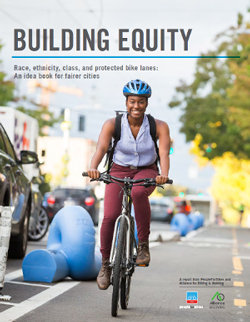These reports, how-to guides, and infographics from Advocacy Advance help advocates and public officials better understand federal funding for biking and walking.
 Primer on Federal Funding for Bicycle and Pedestrian Projects
Primer on Federal Funding for Bicycle and Pedestrian Projects
This brief report provides a brief overview of federal bike/ped spending, including overall spending levels on biking and walking over time. Advocates and concerned citizens working to fund a particular project or program will benefit from this primer's suggested research questions.
 Lifting the Veil on Bicycle & Pedestrian Spending
Lifting the Veil on Bicycle & Pedestrian Spending
This report benchmarks planned bicycling and walking project spending in the Statewide Transportation Improvement Program (STIP) and breaks down how state Departments of Transportation can become more transparent and responsive to community needs. Don't miss the 50 state Score Cards to see how your state plans to spend its transportation funding.
 Key Data Sources: Federal Investments in Bicycling and Walking in Your Community
Key Data Sources: Federal Investments in Bicycling and Walking in Your Community
Data on federal funding is valuable in understanding the range of programs that fund bicycle and pedestrian projects — and whether your state currently utilizes federal funding programs effectively. This resource is intended to help you in identifying the role of federal dollars in your community with a list, summary and links to 11 helpful sources of funding data.
Moving Ahead for Progress in the 21st Century (MAP-21) was passed in the summer of 2012 and replaced the last federal transportation authorization, SAFETEALU. MAP-21 retains funding for biking and walking in a renamed and restructured program: Transportation Alternatives. This factsheet sheet discusses changes to the programs and how to access funds under the new law.
Every federal funding program has specific requirements that must be met in order to be eligible for federal support. While eligibility are determined on a case-by-case basis, there are general rules around which projects and initiatives fit where. This table indicates potential eligibility for pedestrian and bicycle projects under federal highway and transit programs.
These infographics show how federal dollars flow from Congress to your community under MAP-21, the federal transportation bill, in various programs. These infographics also offer advocacy tips for each stage of the process.
View flowchart for the Transportation Alternatives Program »
View flowchart for the Highway Safety Improvement Program »
View flowchart for the Congestion Mitigation and Air Quality Program »
View flowchart for the Surface Transportation Program »
This data table shows the status of implementation of the Transportation Alternatives Program and the Impact on Safe Routes to Schools. Updated 12/1/13.
 How Metropolitan Planning Organizations Plan for and Fund Bicycling and Walking Investments
How Metropolitan Planning Organizations Plan for and Fund Bicycling and Walking Investments
Developed by Advocacy Advance's Bike/Ped-Friendly MPO Working Group, this resource identifies best practices to effectively integrate bicycling and walking needs into the MPO planning and funding process in general, and related to the competitive grant program in particular.
 Examples of Regional Applications for Transportation Alternative Program Funding
Examples of Regional Applications for Transportation Alternative Program Funding
This report is intended as a guide for MPO staff setting up competitive grant process applications. It spotlights example MPO applications that will help regional transportation staff evaluate potential projects for federal TA funding.
 Working with Metropolitan Planning Organizations: Five Lessons for Advocates
Working with Metropolitan Planning Organizations: Five Lessons for Advocates
This report spotlights proven ways that biking and walking advocates can work with their Metropolitan Planning Organizations to unlock crucial federal funds for healthier, safer communities.
These reports - created by regional agency staff in association with our Navigating MAP-21 Workshops - outline the grant process of federal dollars spent at the state and local level.
This report examines some of the states that have successfully dedicated federal Highway Safety Improvement Funds to reduce bicycle and pedestrian fatalities and crashes.
The Federal Lands Access Program (FLAP) is a new program under MAP-21. Funds can be used to improve transportation facilities (i.e. public highway, road, bridge, trail, or transit system) that are located on, adjacent to, or provide access to federal lands.









